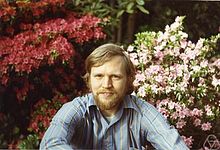H. Blaine Lawson
| H. Blaine Lawson, Jr. | |
|---|---|
 |
|
| Born |
January 4, 1942 Norristown, Pennsylvania |
| Citizenship |
|
| Fields |
Algebraic cycles Calibrated geometry Minimal surfaces |
| Institutions | Stony Brook University |
| Doctoral advisor | Robert Osserman |
| Doctoral students | Michael T. Anderson |
| Notable awards | Leroy P. Steele Prize (1975) |
Herbert Blaine Lawson, Jr. is a mathematician best known for his work in minimal surfaces, calibrated geometry, and algebraic cycles. He is currently a Distinguished Professor of Mathematics at Stony Brook University. He received his PhD from Stanford University in 1969 for work carried out under the supervision of Robert Osserman.
Lawson found in 1970 a method to solve free boundary value problems for unstable Euclidean constant-mean-curvature surfaces by solving a corresponding Plateau problem for minimal surfaces in S3. He constructed compact minimal surfaces in the 3-sphere of arbitrary genus by applying Morrey's solution of the Plateau problem in general manifolds. This work of Lawson contains a rich set of ideas, among them the conjugate surface construction for minimal and constant mean curvature surfaces.
The theory of calibrations, whose roots are in the work of Marcel Berger, finds its genesis in a 1982 Acta Mathematica paper of Reese Harvey and Blaine Lawson. The theory of calibrations has grown to be important because of its many applications to gauge theory and mirror symmetry.
In his 1989 Annals of Mathematics paper "Algebraic Cycles and Homotopy Theory", Lawson proved a theorem which is now called the Lawson suspension theorem. This theorem is the cornerstone of Lawson homology and morphic cohomology which are defined by taking the homotopy groups of algebraic cycle spaces of complex varieties.
...
Wikipedia
